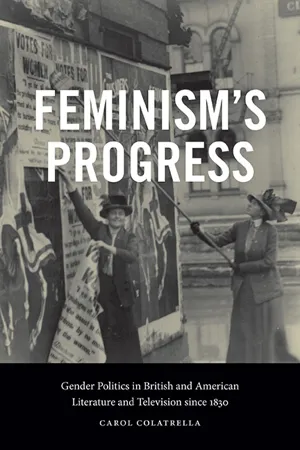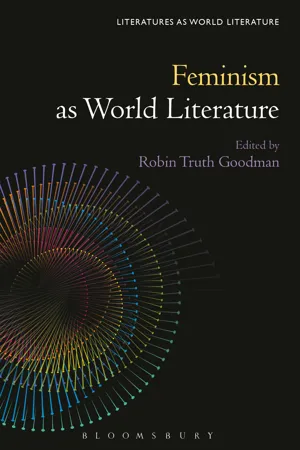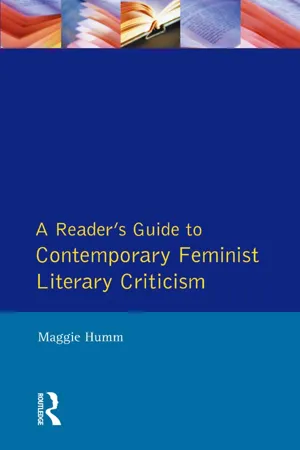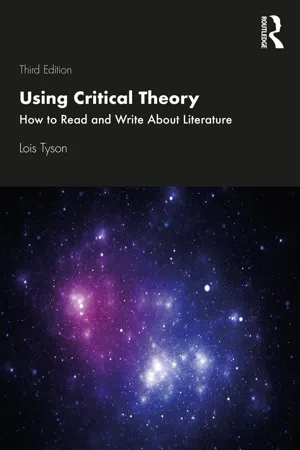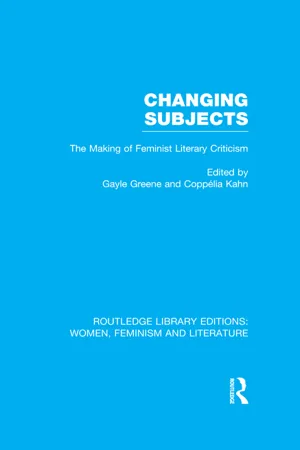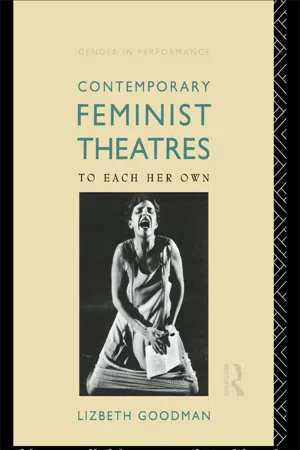Literature
Feminist Literature
Feminist literature refers to literary works that explore and advocate for the rights, experiences, and perspectives of women. It often challenges traditional gender roles, stereotypes, and power dynamics, and addresses issues such as sexism, discrimination, and inequality. Through storytelling, poetry, and essays, feminist literature aims to raise awareness, promote gender equality, and empower women.
Written by Perlego with AI-assistance
Related key terms
10 Key excerpts on "Feminist Literature"
- eBook - ePub
SUNY series in Feminist Criticism and Theory
Gender Politics in British and American Literature and Television since 1830
- Carol Colatrella(Author)
- 2023(Publication Date)
- SUNY Press(Publisher)
Feminism’s Progress looks at fictional information—plots, characters, settings, and voice—in selected narratives that incorporate discussions and illustrations of women’s empowerment, social collectivity, equality, resistance, and other issues important to supporters of women’s rights and feminists of different waves. Fictional texts from the nineteenth century to the present—novels, stories, television shows, and films—identify social problems such as bias, discrimination, and violence, and explore feminist arguments promoting gender equity in marriage, education, careers, and politics. My subject includes representations of suffrage movements and women politicians in discussing fictions that recommend reconfiguring the sex/gender system and encouraging individuals to act collectively and cooperatively with others to ensure an equitable future for all.Many theoretical accounts of gender, literature, and culture and fictional texts have helped shape my understanding of feminism—how to define it, ways to evaluate its appearance in literature and media, and its application as a reading strategy. Moira Ferguson explains in the preface to her anthology of British women writers: “By feminist I mean those ideas and actions that advocate women’s just demands and rights, or that counter or offset, at any level, the socio-cultural, sexual and psychological oppression and exploitation of women.”4 Rachel Blau Duplessis offered a dynamic account of feminism in a 2015 interview: “For me feminism is sex-gender justice intertwined with social and economic justice, and it involves female co-equality with males amid female differences, the positions working in endless dialectical movement. Women’s gains in agency, co-equality, and legal redress should not come at the expense of others who endure social wrongs, although there is undoubtedly some cost to people’s claims of power-over-others and to their claims of interpretive hierarchies of importance where women rank as lesser.”5 Sharing a core belief in feminism’s focus on advocacy, equality, and opposition to inequity, these definitions align with the succinct one provided by bell hooks: “feminism is a movement to end sexism, sexist exploitation, and oppression.”6 - eBook - ePub
Advocacy Research in Literacy Education
Seeking Higher Ground
- Meredith Rogers Cherland, Helen Harper(Authors)
- 2023(Publication Date)
- Routledge(Publisher)
Walkerdine (1987) suggested, “If new content in whatever form does not map onto the crucial issues of desire, then we should be surprised if it fails as an intervention.” (p. 62) More generally, Harper’s study, like Cherland’s and Finders’, speaks to the need for close and careful examination of social, psychological, and historical context in developing feminist interventions (or any form of advocacy work) in literacy education. This context speaks not only to what happens in schools but also to what happens out of schools in the wider society.These studies—in showing the gendered nature of literacy practices, the struggle with progressive language and literacy school programs, and even the struggle with explicit feminist texts and pedagogical intervention—exemplify the field. However, an exciting and relatively new line of feminist research that offers a broader perspective but relates nonetheless to advocacy work in literacy education is found in the field of feminist cultural studies.Feminist Cultural Studies and Advocacy Research in Literature
There are of course alternative spaces outside of the purview of adults and official school doctrine where individuals construct the world and themselves. One of these spaces is popular culture. A growing number of studies have offered textual analyses of pop culture products and events, as well as ethnographic studies of child and youth engagement with these products-events. A subset of these studies is focused on girls and women (e.g., Best, 2000 ; Inness, 1998a, 1998b; Mazzarella & Pecora, 2001 ) and at times with their engagement with popular literature and text-based media. Angela McRobbie’s (1991, 1997, 2000) study of girls reading of teen magazines—”zines”—offered the first foray into this field, as did Linda Christian-Smith’s study of teens’ popular romance reading (1993). The Christian-Smith study drew on an early classic study by Janice Radway (1984) - eBook - ePub
- Robin Truth Goodman(Author)
- 2022(Publication Date)
- Bloomsbury Academic(Publisher)
Feminism as World Literature redefines the thematic and theoretical contents of World Literature in feminist terms as well as rethinking feminist terms, analyses, frameworks, and concepts in a World Literature context. The authors recognize genres, strategies, and themes of World Literature that demonstrate feminism as integral to the world-making gestures of literary form and production. In this introduction, I argue that a feminist World Literature’s practices, questions, theories, frameworks, materials, and modes of analyses are particularly urgent now at a time when democracy is possibly at risk of not surviving.World Literature criticism may, indeed, identify World Literature in contrast not just to feminism but also to femininity, as femininity conventionally is associated with interiority, the body, particularity, contingency, stability, nature, the local, the traditional, and the sentimental rather than the global, the conceptual, the expansive, or the transcendent. Simone de Beauvoir, for example, wrote of femininity as “imminent” in its hominess and grounded in the naturalized physicality of a woman’s body, especially in her reproductive, care, love, and familial capacities. Beauvoir thought that women’s relation to the home as a defense against the world reduced her to dependency and obstructed her liberty: “The home becomes the center of the world and even its only reality: . . . refuge, retreat, grotto, womb, it gives shelter from outside dangers; it is this confused outer world that becomes unreal . . .” (1980 : 450). In a postcolonial context, Partha Chatterjee has agreed, claiming that “nationalism’s success [is] in situating the ‘women’s question’ in an ‘inner’ domain of sovereignty far removed from the arena of political contest” (1997 : 241), where women invoke “tradition” and cultural feeling against the onslaught of political temporalities, abstract generalities, and imperializing modernity. Yet, in what sense can we say that the tradition of representing these “‘inner’ domains of sovereignty” may be focusing on the “women’s question” in order to address broader political relations or even world political relations? Fredric Jameson might identify this “women’s question”—albeit problematically—as part of a “national allegory,” a “third-world” allegory, or even a world allegory in that the domestic context, private life, or locality projects a “political dimension”: an “embattled situation of the public third-world culture and society” (1986 - Maggie Humm(Author)
- 2015(Publication Date)
- Routledge(Publisher)
celebrating women’s writing, Spender asked probing questions about the power of language: should we be speaking about separate languages for men and women or dialects (genderlects)? In other words are there sex-preferential or sex-exclusive ways of speaking? Is linguistic sexism the cause or effect of women’s oppression? When does it appear? What are its boundaries and how do men control language? Spender argued that these binaries are not innate in language patterns but are cultural discourses which are inscribed within the media and in popular and traditional literature. The challenge then to feminist criticism was to investigate and to re-figure gender differences, and to describe potentially new relationships between gender, language and literature.A major problem for feminist criticism in the 1970s, indeed for feminist criticism today, is that feminist work lacks institutional power. The feminist critique of language needed to be linked to a critique of the construction and dissemination of knowledge in the academy. For feminist criticism to have a space, academic respect must be granted to its views. The feminist project of literary discovery was intimately linked therefore to a feminist pedagogical project – to the teaching and the interpretation of literature. It is not surprising that new pedagogical strategies were simultaneously pursued by leading feminist critics. Early examples include Elaine Showalter’s essay ‘Women and the Literary Curriculum’ which appeared in College English in 1970; essays on women writers by Showalter, Rapone and Snitow which appeared, not in literary journals, but in the first anthology of the American women’s movement –Radical Feminism(1973); and Adrienne Rich’s ‘Writing as Re-vision’ which also appeared in College English (1972).Elaine Showalter’s A Literature of Their Own (1977) was an important contribution to this agenda. Reflecting on Woolf’s A Room of One’s Own, Showalter faced the similar issue of women’s exclusion from the academy. Charting a long history of literary women, she brought attention to undervalued nineteenth-century writers such as Sarah Grand and George Egerton. Rather than defining a ‘universal’ woman’s text, Showalter preferred to identify a female ‘subculture’ which created those texts. She replaced the traditional periods of literary history with an alternative three-stage process which she couched as a growth into consciousness – feminine, feminist and female. Cautioned by later critics for adopting a literary standard more applicable to the late twentieth century and for her resistance to theory, Showalter went on to develop her ideas in ‘Toward a Feminist Poetics’ (1979), ‘Feminist Criticism in the Wilderness’ (1981) and subsequent writings. In these essays Showalter divided criticism into two distinct categories: the first type focused on the woman reader, a consumer of literature, and the second focused on the woman writer, a producer of textual meaning. Showalter described four models of gender difference – biological, linguistic, psychoanalytic and cultural – and claimed that these would be best addressed by a gynocentric model of feminist criticism. Following the publication of New French Feminisms (1980), Showalter brought French feminists into her 1981 essay. Her quadruple focuses closely resemble those of Simone de Beauvoir’s The Second Sex- eBook - ePub
Women and Judaism
New Insights and Scholarship
- Frederick E. Greenspahn(Author)
- 2009(Publication Date)
- NYU Press(Publisher)
Was this simply because men had written far, far better literary works than women? Or, as Kolodny and others suggested, was it because, in their roles as editors, publishers, and patrons, men exercised economic and cultural clout, functioning as tastemakers, as arbiters of excellence? Men, it was suggested, responded to literature that emerged from and spoke to men’s experiences and sensibilities. Looking at “how we read” involved noticing the ways that gender was portrayed in works by both men and women and linking these portrayals to more broadly based world views assumed and conveyed in literary works. It entailed placing literary figures of gender in the wider context of the social, economic, and political systems that shape the way men and women experience their lives and in which writers ply their craft. Addressing either of those concerns—what and how we read—from a feminist viewpoint could draw fire from more established (and mostly male) scholars. When feminist critics focused on “what we read,” they often noticed an imbalance, for example, between the number of men and women writers whose works were included in high school or university courses or mandated by school curricula. To address this, women critics read with a fresh eye, bringing to light women writers whose works had been ignored or undervalued, “rediscovering a lost body of writing.” 4 They introduced a new set of authors into literature classes—new in the sense of not having been studied seriously before. From Elizabethan English literature to contemporary American writing, literature courses began to take on a new shape as feminist critics chipped away at conventional ideas about whose writing “counts” and whose does not. However, such challenges to established literary judgment came at a price. Not infrequently, colleagues would accuse professors of women’s studies of lowering their aesthetic standards by concentrating on inferior works - eBook - ePub
Using Critical Theory
How to Read and Write About Literature
- Lois Tyson(Author)
- 2020(Publication Date)
- Routledge(Publisher)
Chapter 6 Using concepts from feminist theory to understand literature Why should we learn about feminist theory? As we saw in Chapter 4, psychoanalytic theory asks us to examine the ways in which our personal identity is formed by our early emotional experience within the family. In Chapter 5 we saw that Marxist theory asks us to examine the ways in which our personal identity is formed by the socioeconomic system in which we live. Feminist theory asks us to examine, instead, the ways in which our personal identity is formed by our culture’s definitions of what it means to be a man or a woman. For from a feminist perspective, our experience of ourselves, our family, and the socioeconomic system in which we live depends to a large extent on our sex: on the ways in which men and women are treated differently and on the ways in which men are socialized to be masculine and women are socialized to be feminine. Specifically, in most cultures, men occupy most or all positions of power, which is why those cultures are called patriarchies or patriarchal cultures. For the word patriarchy, broadly defined, refers to any society in which men hold most or all of the power. In a patriarchy, women suffer varying degrees of oppression depending on such circumstances as their race, ethnicity, socioeconomic class, religion, gender identification (our internal sense of our own gender, which may or may not match our apparent biological sex at birth), sexual orientation, disability, age, and the country or region in which they live. Feminism, therefore, seeks to understand the variety of ways in which women are oppressed—socially, economically, politically, and psychologically—in order to reduce, if not eliminate, their oppression - eBook - ePub
Feminist Review
Issue 42: Feminist Fictions
- The Feminist Review Collective(Author)
- 2005(Publication Date)
- Routledge(Publisher)
Feminist Writing: Working with Women's Experience Frigga HaugDOI: 10.4324/9780203990698-3For some years black and feminist would-be revolutionaries have also been trying to influence the curricula outside their ghetto. A favourite object of attack are the lists of books, knowledge of which many American high schools require from students in their first and second semesters.(J.von Uthmann, in FAZ, 19.2.92)The author mentions ‘scandalous’ examples like the inclusion of Sappho, Jane Austen and Virginia Woolf on the official curriculum. The thought that makes the author shudder, the improvement of the world through literature, gives us cause for hope.Here, my interest in recent Feminist Literature is concerned with the following questions. How is knowledge, as the precondition of the capacity for action, made possible, and why is it that today feminist writing takes up this task in an exemplary way? Novels from the 1980s by Marge Piercy, Barbara Wilson and Sarah Schulman form the basis of my reflections. Model analyses refer to two novels by Marge Piercy.Experience and theory
The Political Project as Problem of Knowledge and Mediation
The theoretical level appears appropriate to the search for knowledge. The concept, by abstracting from multicoloured diversity provides an understanding of the issue, present information about what is essential provides orientation and allows a great deal to be disregarded and certain things to be retained. Experience, interest and commitment are part of the process of abstraction. The feminist critique of traditional concept-formation aims above all at the neglect of female experiences and the consequent false universality of theory and categories, and in particular at the androcentrism of centuries of occidental theory.The wearisome problem that follows from such a critique is the necessity of expressing women’s experiences, of finding concepts, of reconstructing theories, of renewal. Contained within that there is, among other things, the problem of establishing a relationship at all between the levels of experience and theory. We have been trying for more than a decade, with work on memory in various women’s projects,1 - eBook - ePub
Changing Subjects
The Making of Feminist Literary Criticism
- Gayle Greene, Coppélia Kahn, Gayle Greene, Coppélia Kahn(Authors)
- 2012(Publication Date)
- Routledge(Publisher)
Beyond Feminist Aesthetics – enlist theory to illuminate the relation of literature to change. DuPlessis demonstrates ways that twentieth-century women writers challenge the gender ideology inscribed in narrative forms; Hite describes ways that these challenges are as radical as those of canonized “postmodern” male writers; and Felski examines the problems of defining a “feminist aesthetic.” In Changing the Story I analyze feminist metafiction as emerging from a decade of rapid change for women and developing narrative strategies that allow readers to work through processes of change. Such approaches enlist theory, or theories, to interrogate cultural assumptions and categories, to explore interactions of literary conventions with social conventions, with an eye to feminist politics.I'm urging that feminist scholars write with a clearer sense of responsibility to a social movement, that we try to revitalize some important connections – between ourselves and our audience, our writing and its effects. That we think about reaching people outside academia who might actually read our books if they were more interesting. I'd urge that we ask, of our books, articles, and conference papers: Is this a necessary or useful idea? To whom is it necessary or useful? Am I saying this to clarify some idea or information or to insert myself into a critical discourse whose purpose I have not questioned, perhaps, even, to place myself beyond accountability by being so ingenious that no one can possibly understand me?22 I'd urge that we stop dancing attendance on those who still have power to confer rewards and benefits (and there are endless versions of this insidious game), that we envision our audience not as that patriarch in our head who may finally confer approval on us, but think of ourselves, rather, as reaching people to whom we have a responsibility, whom we - eBook - ePub
Ambiguous Discourse
Feminist Narratology and British Women Writers
- Kathy Mezei, Kathy Mezei(Authors)
- 2000(Publication Date)
- The University of North Carolina Press(Publisher)
Introduction : Contextualizing Feminist Narratology Kathy MezeiYes, yes, if you please, no reference to examples in books. Men have had every advantage of us in telling their own story. Education has been theirs in so much higher a degree; the pen has been in their hands. I will not allow books to prove any thing.—Austen , PersuasionAnne Elliot’s retort to Captain Harville as they debated the differences between men’s and women’s “nature” pinpoints the essence of feminist narratology—the context of how stories are told, by whom, and for whom.This collection is the first to gather together essays that combine feminist and narratological readings of women’s texts. In their selection of British women writers from Jane Austen to Jeanette Winterson, the contributors focus on writers who are conspicuously self-conscious and iconoclastic in their deployment of narrative techniques. While seeking to decode subversive, evasive, or perplexing narrative strategies in Austen or Woolf or Mina Loy, the contributors recognized the value of a feminist narratology in interpreting these strategies, in proving, as Anne Elliot might say, some thing . In 1986 Susan Lanser described the contingent relation between feminism and narratology, which she named “feminist narratology”: “My … task [is] to ask whether feminist criticism, and particularly the study of narratives by women, might benefit from the methods … of narratology and whether narratology, in turn, might be altered by the understandings of feminist criticism and the experience of women’s texts” (342). Taking up the “task” in turn, these essays explore and expose “gender’s effect on the level of discourse” (Warhol, Gendered Interventions - eBook - ePub
Contemporary Feminist Theatres
To Each Her Own
- Lizbeth Goodman(Author)
- 2003(Publication Date)
- Routledge(Publisher)
strategy, a project which seeks change. In feminist theatre, the change sought is that of the designated roles of women in the theatre. Women’s roles as makers and spectators are emphasized, as well as women’s roles (as characters in plays, and as performers) on stage. Alcoff’s proposal, when applied to feminist theatre, emphasizes action and allows for differences between feminist theatres. Without such a flexible framework for evaluation, the study of feminist theatre tends to divide between theory and practice. With such a framework, it becomes possible to define feminist theatre as a form of cultural representation made by women, which is informed by the situated perspectives of its makers, its performers, its spectators and its critics.For the purposes of this book, then, feminist theatre will be defined in a flexible way as that theatre which aims to achieve positive re-evaluation of women’s roles and/or to effect social change, and which is informed in this project by broadly feminist ideas. Feminist theatre thus defined may include all the different schools of feminist thought and practice. It allows for a cultural emphasis on ‘women’s experience’, yet it acknowledges that some feminists reject this idea as potentially reductive or essentialist. Crucially, this definition allows for a diversity of approaches and perspectives among practitioners.A flexible definition of ‘feminist theatre’ can be employed in a study of the work of particular theatre groups. In this kind of feminist theatre studies, the primary questions are: who are the members of theatre groups? What do they aim to achieve? How do they operate? What do they think of their own work, as well as of the relevance of feminism to their theatre practice?
Index pages curate the most relevant extracts from our library of academic textbooks. They’ve been created using an in-house natural language model (NLM), each adding context and meaning to key research topics.
